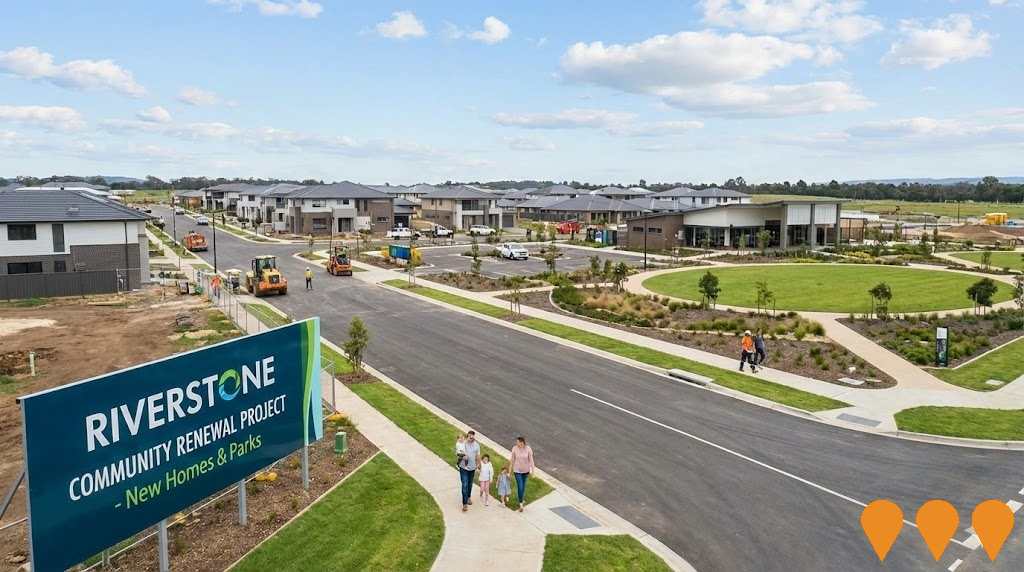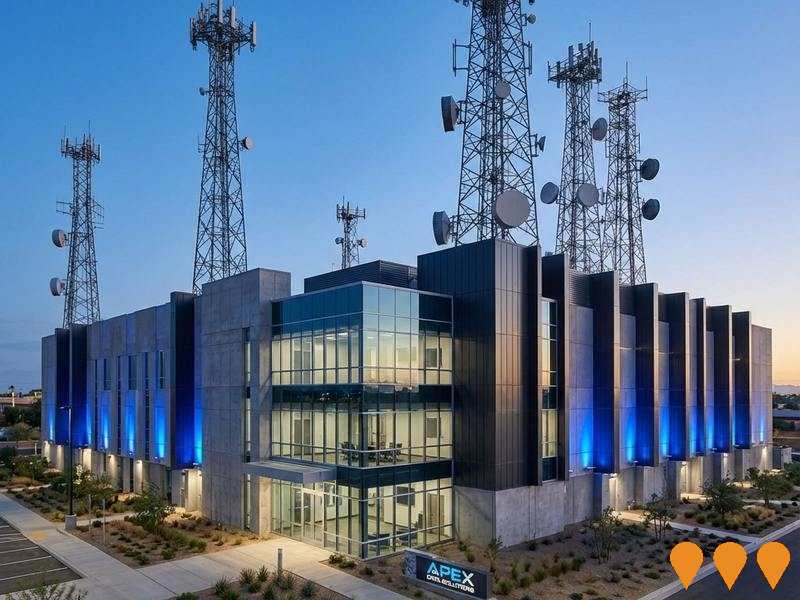Chart Color Schemes
est. as @ -- *
ABS ERP | -- people | --
2021 Census | -- people
Sales Activity
Curious about local property values? Filter the chart to assess the volume and appreciation (including resales) trends and regional comparisons, or scroll to the map below view this information at an individual property level.
Find a Recent Sale
Sales Detail
Population
Myrtleford is positioned among the lower quartile of areas assessed nationally for population growth based on AreaSearch's assessment of recent, and medium term trends
Myrtleford's population was 4,745 as of Aug 2021. By Aug 2025, it decreased to around 4,651, a drop of 94 people (2%). This change is inferred from ABS' Jun 2024 estimate of 4,642 and 18 new addresses since the Census date. The population density is 8.4 persons per square kilometer. Overseas migration primarily drove recent growth.
AreaSearch uses ABS/Geoscience Australia projections for SA2 areas (released in 2024 with a base year of 2022), and VIC State Government's Regional/LGA projections for uncovered areas (adjusted using weighted aggregation). Future trends suggest a sub-median increase outside capital cities, with Myrtleford expected to grow by 218 persons to 2041, a 4.4% total gain over 17 years.
Frequently Asked Questions - Population
Development
AreaSearch assessment of residential development drivers sees a low level of activity in Myrtleford, placing the area among the bottom 25% of areas assessed nationally
Myrtleford has recorded approximately 20 residential properties granted approval annually. Over the past five financial years, from FY-21 to FY-25, a total of 101 homes were approved. As of FY-26, four residential properties have been approved.
Despite recent population decline, development activity has remained adequate relative to other areas. The average construction cost value for new properties is $492,000. In terms of commercial development, $6.3 million in approvals have been registered during the current financial year, indicating limited focus on commercial projects.
Compared to the rest of Victoria, Myrtleford has around two-thirds the rate of new dwelling approvals per person. Nationally, it ranks among the 45th percentile of areas assessed for housing choices, suggesting more limited options for buyers and supporting demand for existing homes. The majority of new building activity consists of detached houses (92.0%), with townhouses or apartments making up the remaining 8.0%, preserving the area's low-density nature. This focus on detached housing may attract space-seeking buyers. As of now, there are an estimated 373 people per dwelling approval in Myrtleford, reflecting its quiet and low-activity development environment. Looking ahead, projections indicate that Myrtleford is expected to grow by 206 residents by the year 2041. Based on current development patterns, new housing supply should be able to meet demand, offering favorable conditions for buyers and potentially facilitating further population growth beyond current projections.
Frequently Asked Questions - Development
Infrastructure
Myrtleford has emerging levels of nearby infrastructure activity, ranking in the 22ndth percentile nationally
Changes to local infrastructure significantly impact an area's performance. AreaSearch has identified one major project expected to affect this region: Porepunkah Roadworks and Rail Trail Reconstruction. Other notable projects include Alpine Shire Land Development Strategy 2024, North East Rail Line Upgrade, and Inland Rail Beveridge to Albury. The following list details those most relevant.
Professional plan users can use the search below to filter and access additional projects.
INFRASTRUCTURE SEARCH
 Denotes AI-based impression for illustrative purposes only, not to be taken as definitive under any circumstances. Please follow links and conduct other investigations from the project's source for actual imagery. Developers and project owners wishing us to use original imagery please Contact Us and we will do so.
Denotes AI-based impression for illustrative purposes only, not to be taken as definitive under any circumstances. Please follow links and conduct other investigations from the project's source for actual imagery. Developers and project owners wishing us to use original imagery please Contact Us and we will do so.
Frequently Asked Questions - Infrastructure
Low and Mid-Rise Housing Policy
State-wide NSW planning reforms via amendments to the State Environmental Planning Policy to enable more diverse low and mid-rise housing (dual occupancies, terraces, townhouses, manor houses and residential flat buildings up to 6 storeys) in well-located areas within 800 m of selected train, metro and light-rail stations and town centres. Stage 1 (dual occupancies in R2 zones statewide) commenced 1 July 2024. Stage 2 (mid-rise apartments, terraces and dual occupancies near stations) commenced 28 February 2025. Expected to facilitate up to 112,000 additional homes over the next five years.
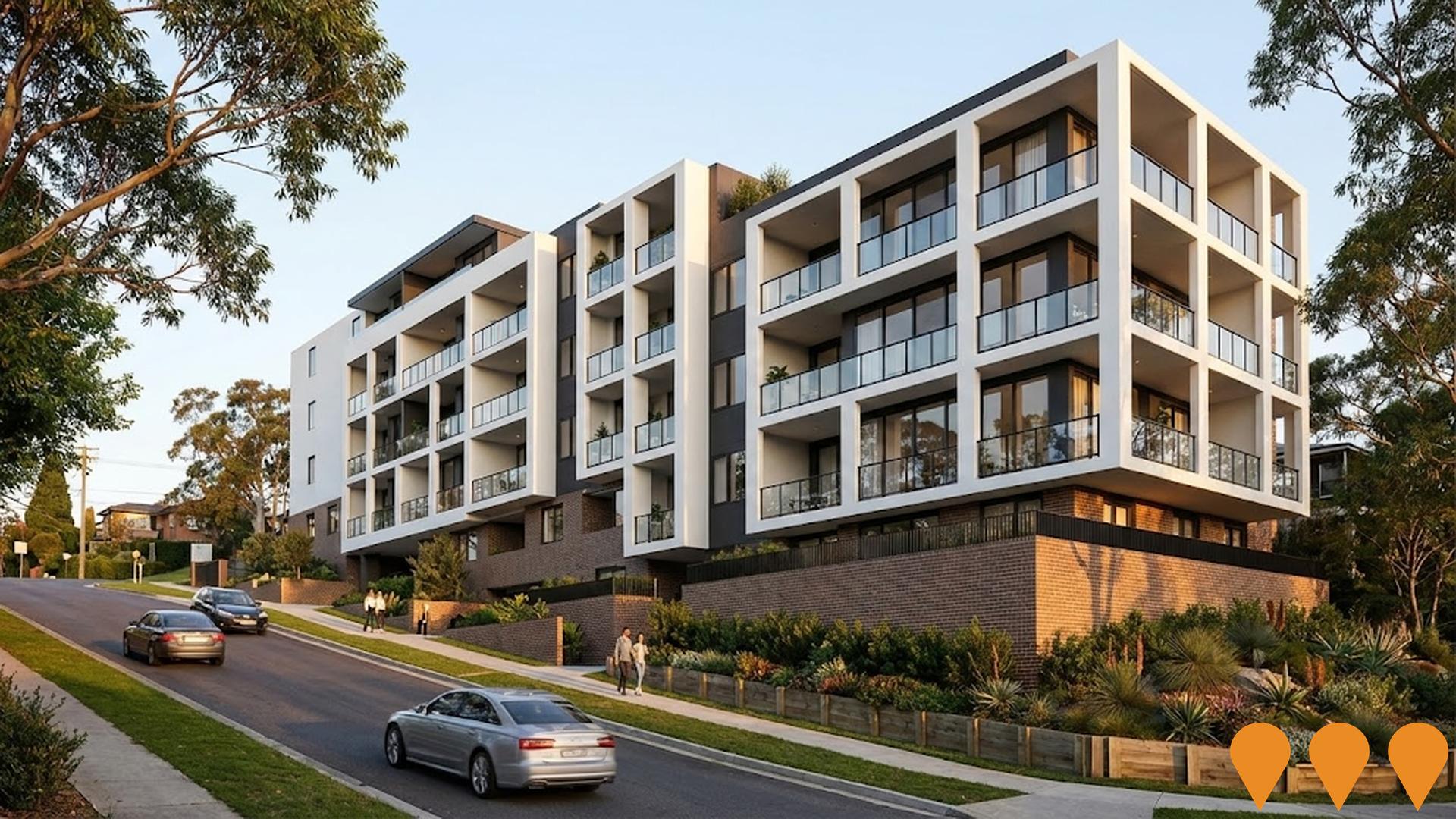
Victorian Renewable Energy Zones
VicGrid, a Victorian Government agency, is coordinating the planning and staged declaration of six proposed onshore Renewable Energy Zones (plus a Gippsland shoreline zone to support offshore wind). The 2025 Victorian Transmission Plan identifies the indicative REZ locations, access limits and the transmission works needed to connect new wind, solar and storage while minimising impacts on communities, Traditional Owners, agriculture and the environment. Each REZ will proceed through a statutory declaration and consultation process before competitive allocation of grid access to projects.
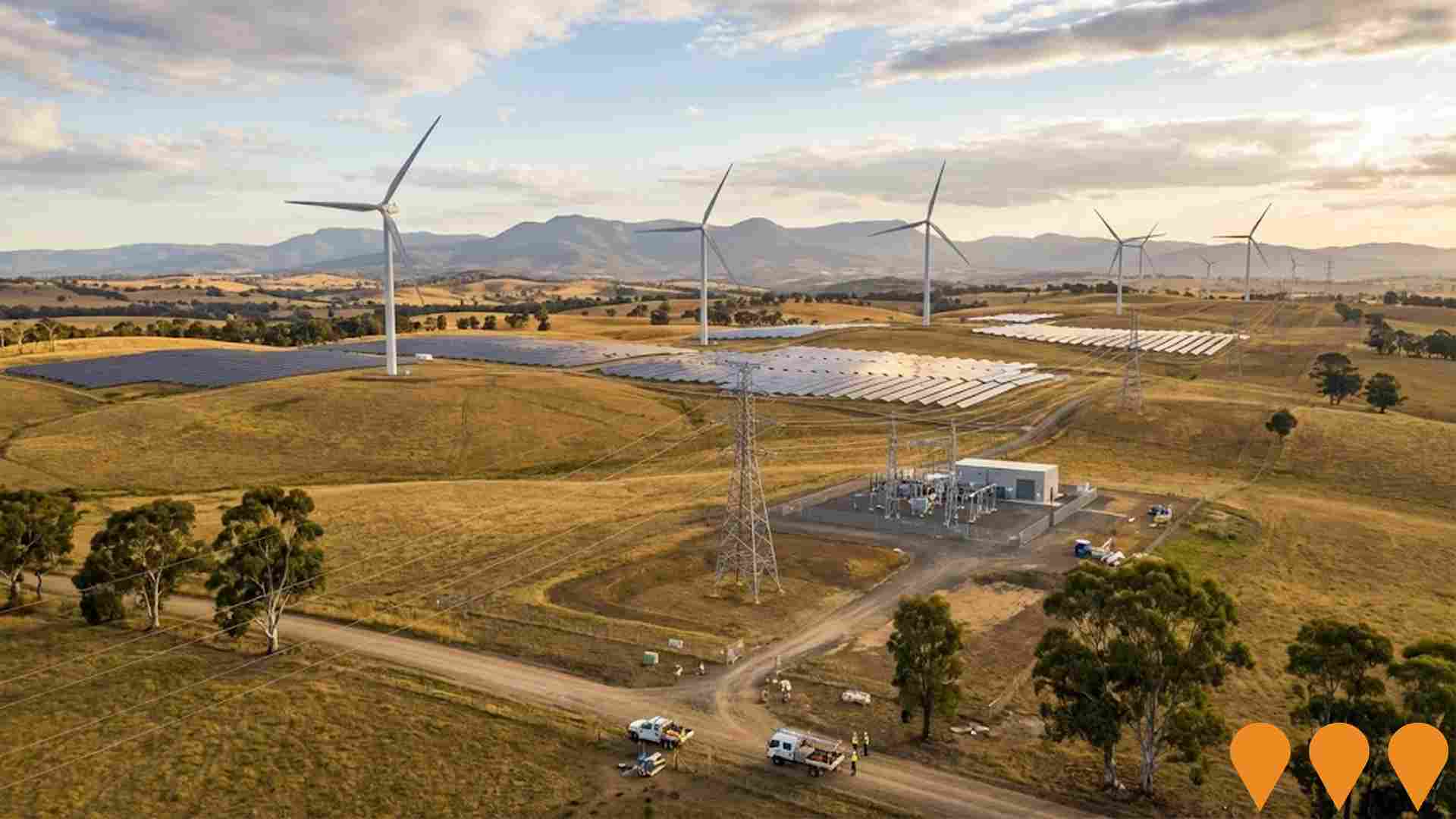
North East Rail Line Upgrade
Major upgrade to the North East Rail Line between Melbourne and Albury-Wodonga, improving freight and passenger services, including track resurfacing, mud-hole removal, drainage improvements, bridge upgrades, and signalling enhancements to allow VLocity trains and better ride quality.
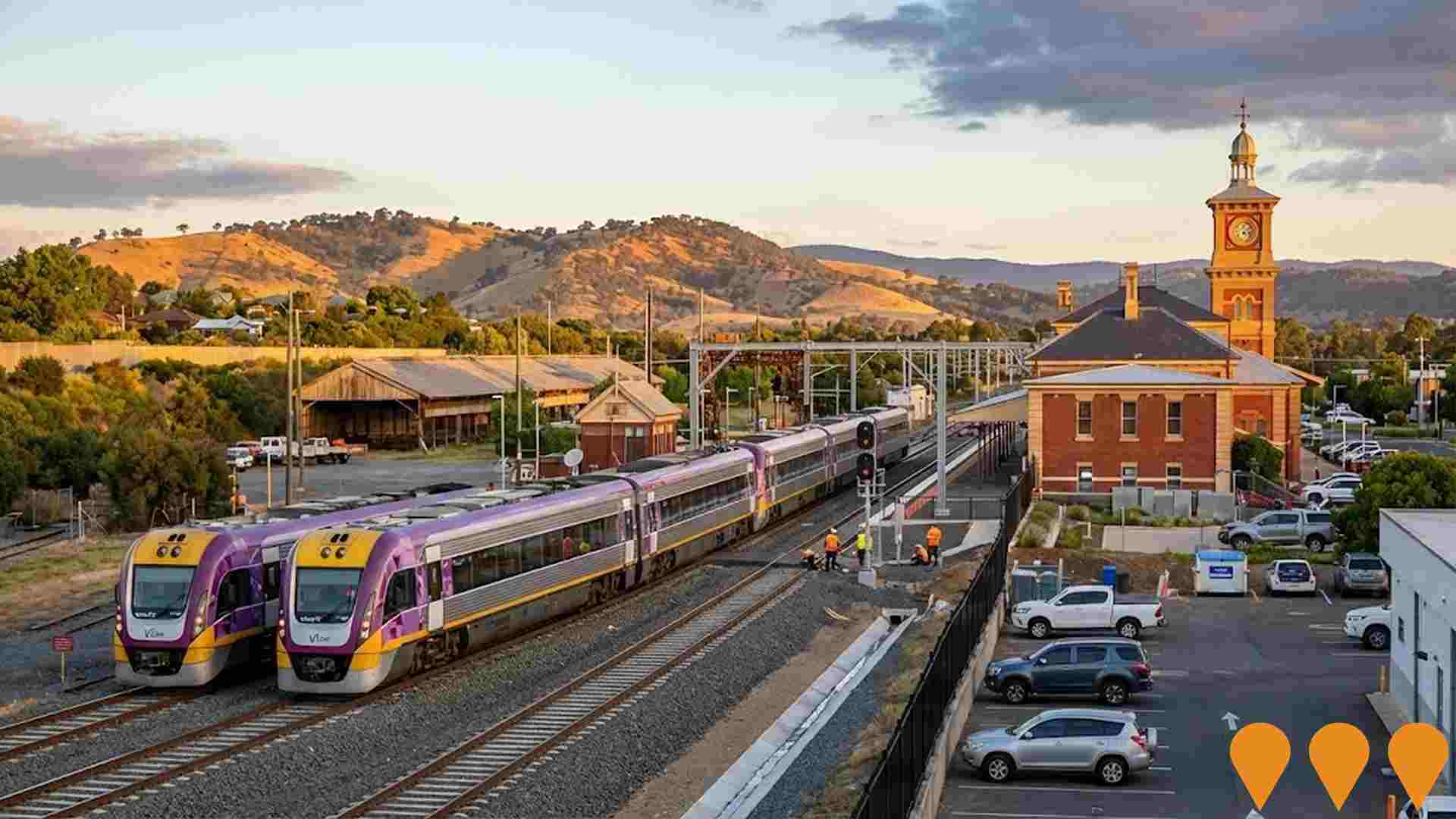
EnergyConnect
Australia's largest energy transmission project. A new ~900km interconnector linking the NSW, SA and VIC grids. NSW-West (Buronga to SA border and Red Cliffs spur) was energised in 2024-2025, connecting the three states via the expanded Buronga substation. NSW-East (Buronga-Dinawan-Wagga Wagga) is under active construction with substation upgrades at Wagga Wagga completed in June 2025 and works well advanced at Dinawan and Buronga. Full 800MW transfer capability is targeted after completion of the eastern section and inter-network testing, expected by late 2027.
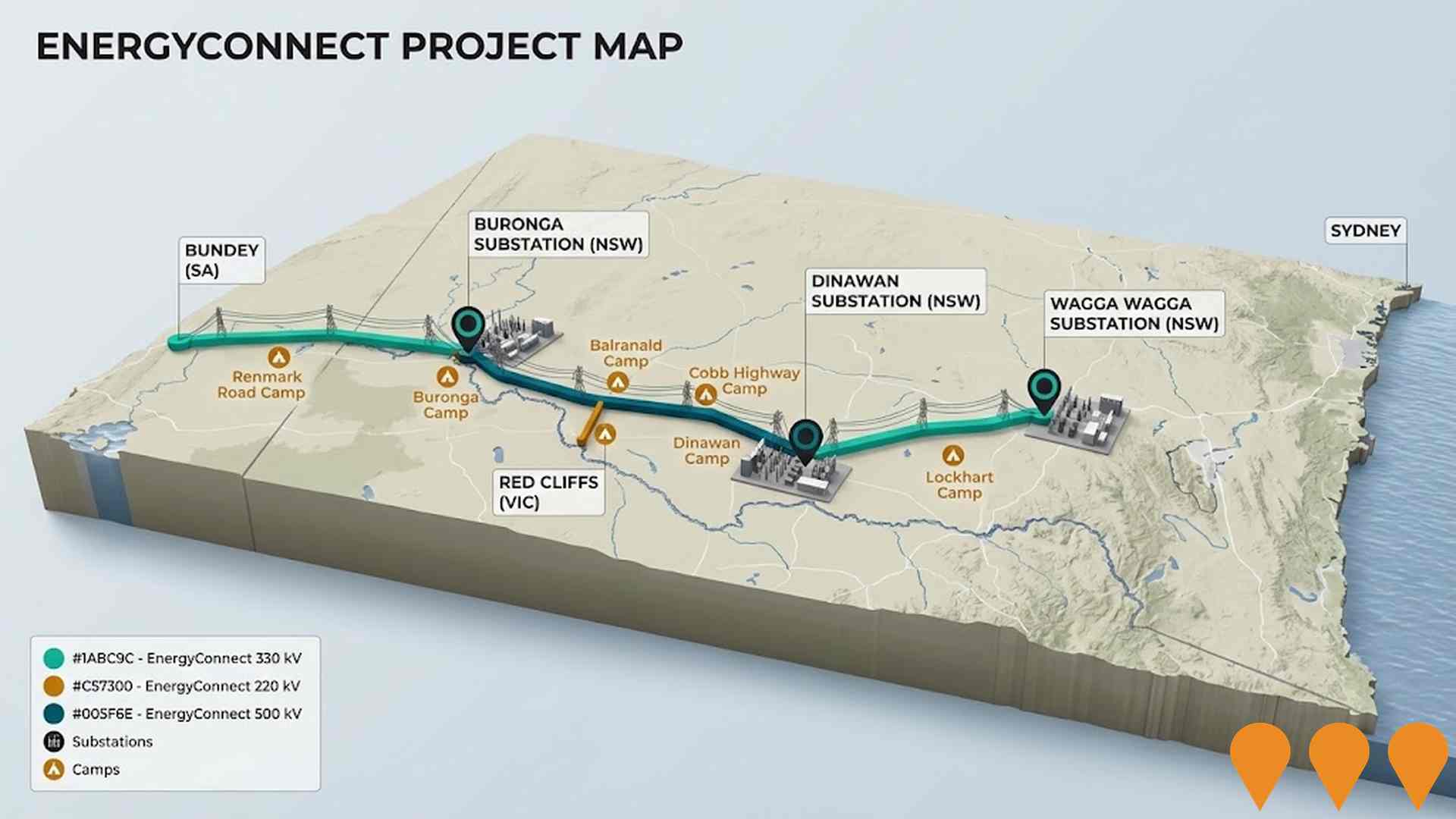
Inland Rail Beveridge to Albury
262km rail corridor upgrade enabling double-stacked freight trains between Beveridge and Albury. Two-tranche delivery with Tranche 1 under construction including bridge replacements and track modifications. John Holland contracted for Tranche 2.
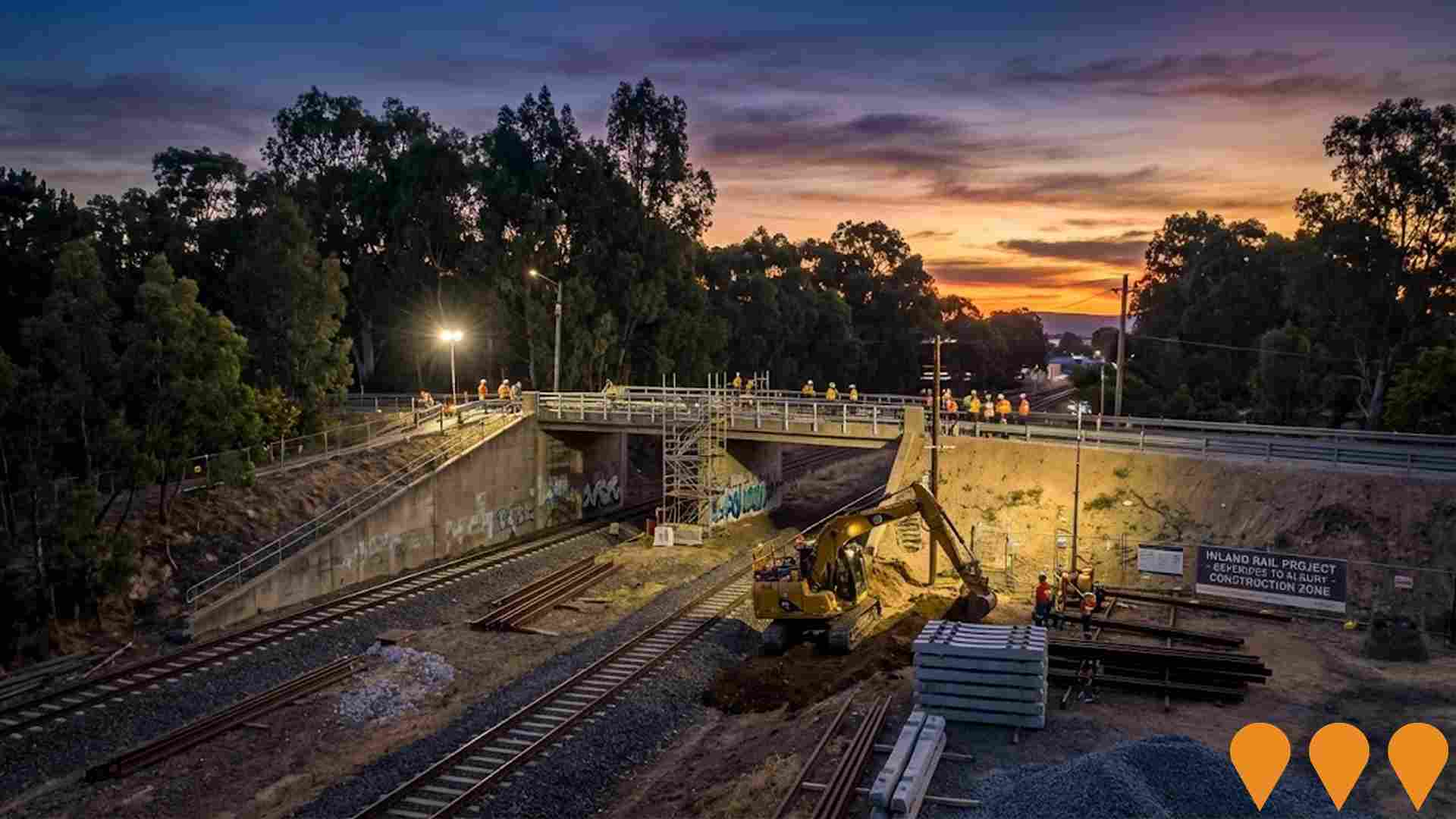
Regional Housing Fund (Victoria)
A $1 billion Homes Victoria program delivering around 1,300 new social and affordable homes across at least 30 regional and rural LGAs, using a mix of new builds, purchases in new developments, renewals and refurbishments. Delivery commenced in late 2023 with early completions recorded; overall fund completion is targeted for 2028.
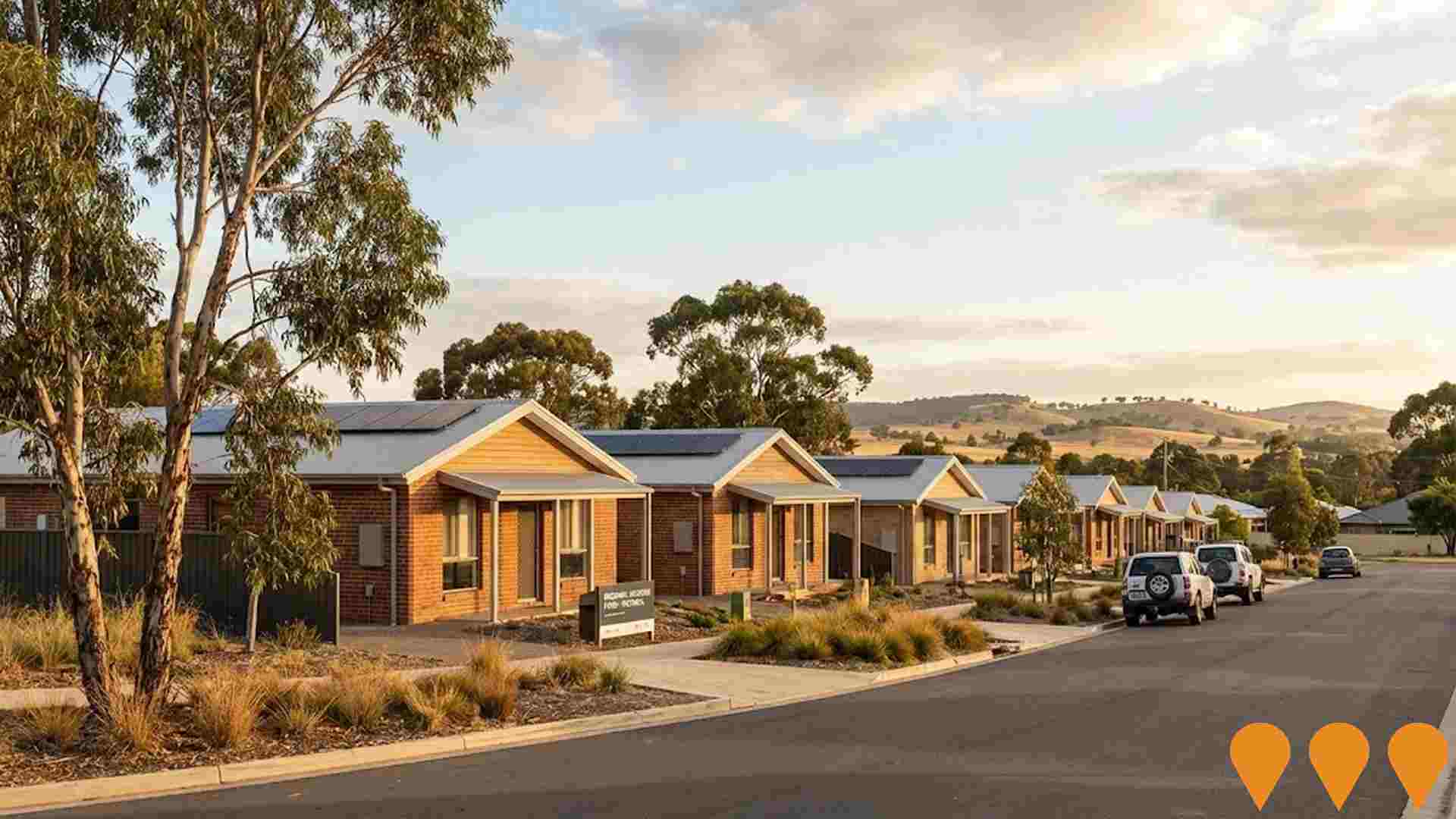
NSW Heavy Vehicle Rest Stops Program (TfNSW)
Statewide Transport for NSW program to increase and upgrade heavy vehicle rest stopping across NSW. Works include minor upgrades under the $11.9m Heavy Vehicle Rest Stop Minor Works Program (e.g. new green reflector sites and amenity/signage improvements), early works on new and upgraded formal rest areas in regional NSW, and planning and site confirmation for a major new dedicated rest area in Western Sydney. The program aims to reduce fatigue, improve safety and productivity on key freight routes, and respond to industry feedback collected since 2022.

Inland Rail - Tottenham To Albury
The Tottenham to Albury section is Victoria's portion of the Inland Rail, upgrading 305 km of rail to allow double-stacked trains. The project is staged, focusing on bridge enhancements and rail modifications.

Employment
Employment conditions in Myrtleford remain below the national average according to AreaSearch analysis
Myrtleford has a skilled workforce with strong representation in manufacturing and industrial sectors. Its unemployment rate was 4.0% as of June 2025.
Employment stability was maintained over the past year. A total of 2,360 residents were employed in June 2025, with an unemployment rate of 4.0%, 0.2% higher than Rest of Vic.'s rate of 3.8%. Workforce participation was on par with Rest of Vic.'s 57.4%. Key employment sectors included health care & social assistance, manufacturing, and agriculture, forestry & fishing.
Manufacturing had a particularly high share of employment at 1.7 times the regional level, while education & training had limited presence at 6.3% compared to the regional average of 9.1%. Employment opportunities exist locally but many residents commute elsewhere for work based on Census data. Over the 12-month period ending June 2025, employment increased by 0.0%, labour force increased by 1.4%, and unemployment rose by 1.3 percentage points. This contrasted with Rest of Vic., where employment fell by 0.9%, labour force contracted by 0.4%, and unemployment rose by 0.4 percentage points. Jobs and Skills Australia's national employment forecasts from May 2025 project a 6.6% increase over five years and 13.7% over ten years. Applying these projections to Myrtleford's employment mix suggests local growth of approximately 5.6%% over five years and 12.3% over ten years, based on simple weighting extrapolation for illustrative purposes only.
Frequently Asked Questions - Employment
Income
Income figures position the area below 75% of locations analysed nationally by AreaSearch
AreaSearch's latest postcode level ATO data for financial year 2022 shows that Myrtleford's median income is $45,849 and average income is $55,287. This is lower than Rest of Vic.'s median income of $48,741 and average income of $60,693. By September 2025, estimated incomes would be approximately $51,424 (median) and $62,010 (average), based on a Wage Price Index growth of 12.16% since financial year 2022. Census data indicates that Myrtleford's household, family, and personal incomes all fall between the 15th and 25th percentiles nationally. Income analysis reveals that 28.9% of Myrtleford's community earns between $1,500 - 2,999 annually, aligning with metropolitan regions where this cohort represents 30.3%. Housing costs are modest in Myrtleford, with 88.2% of income retained, but total disposable income ranks at the 20th percentile nationally.
Frequently Asked Questions - Income
Housing
Myrtleford is characterized by a predominantly suburban housing profile, with above-average rates of outright home ownership
Myrtleford's dwelling structures, as per the latest Census, consisted of 93.9% houses and 6.0% other dwellings (semi-detached, apartments, 'other' dwellings). This compares to Non-Metro Vic.'s 91.6% houses and 8.5% other dwellings. Home ownership in Myrtleford stood at 50.5%, with mortgaged dwellings at 28.8% and rented ones at 20.7%. The median monthly mortgage repayment was $1,400, lower than Non-Metro Vic.'s average of $1,473. Median weekly rent in Myrtleford was $250, compared to Non-Metro Vic.'s $280. Nationally, Myrtleford's mortgage repayments were significantly lower at $1,400 versus Australia's average of $1,863, and rents were substantially below the national figure of $375.
Frequently Asked Questions - Housing
Household Composition
Myrtleford has a typical household mix, with a lower-than-average median household size
Family households constitute 68.3% of all households, including 22.8% couples with children, 35.4% couples without children, and 9.2% single parent families. Non-family households account for the remaining 31.7%, with lone person households at 29.7% and group households comprising 2.0%. The median household size is 2.3 people, which is smaller than the Rest of Vic. average of 2.4.
Frequently Asked Questions - Households
Local Schools & Education
Myrtleford shows below-average educational performance compared to national benchmarks, though pockets of achievement exist
The area's university qualification rate is 18.5%, significantly lower than Victoria's average of 33.4%. Bachelor degrees are the most common at 12.8%, followed by graduate diplomas (2.9%) and postgraduate qualifications (2.8%). Vocational credentials are prevalent, with 39.1% of residents aged 15+ holding them, including advanced diplomas (10.7%) and certificates (28.4%). A total of 24.9% of the population is actively engaged in formal education, comprising 8.9% in primary, 8.2% in secondary, and 2.7% in tertiary education.
Myrtleford's three schools have a combined enrollment of 668 students, with typical Australian school conditions (ICSEA: 1016) indicating balanced educational opportunities. The educational mix includes one primary, one secondary, and one K-12 school.
Frequently Asked Questions - Education
Schools Detail
Nearby Services & Amenities
Transport
Transport servicing is very low compared to other areas nationally based on assessment of service frequency, route connectivity and accessibility
The analysis of public transport in Myrtleford indicates that there are four active transport stops currently operating. These stops offer a mix of bus services. They are served by four individual routes combined, providing a total of 33 weekly passenger trips.
The accessibility to these transport services is rated as limited, with residents typically located 956 meters away from the nearest stop. On average, service frequency across all routes is 4 trips per day, which equates to approximately 8 weekly trips per individual stop.
Frequently Asked Questions - Transport
Transport Stops Detail
Health
Health performance in Myrtleford is well below average with prevalence of common health conditions notable across both younger and older age cohorts
Health data indicates significant challenges for Myrtleford, with high prevalence rates of common health conditions across both younger and older age groups. Only approximately 48% of residents have private health cover, compared to the national average of 55.3%.
The most prevalent medical conditions are arthritis, affecting 10.3% of residents, and mental health issues, impacting 8.7%. A total of 63.3% of residents report no medical ailments, slightly lower than the Rest of Vic's 64.1%. Myrtleford has a higher proportion of residents aged 65 and over at 27.6%, compared to Rest of Vic's 20.7%.
Frequently Asked Questions - Health
Cultural Diversity
Myrtleford ranks below the Australian average when compared to other local markets across a number of language and cultural background related metrics
Myrtleford had a cultural diversity below average, with 84.8% of its population born in Australia, 90.5% being citizens, and 89.2% speaking English only at home. Christianity was the main religion, comprising 58.6%. This compares to 48.2% across Rest of Vic..
The top three ancestry groups were English (27.6%), Australian (27.2%), and Italian (13.7%), which is significantly higher than the regional average of 3.0%. Notably, Dutch representation was overrepresented at 1.6%, Scottish at 8.0% compared to regional averages of 1.6% and 8.3% respectively, and Filipino at 1.2% versus a regional average of 0.6%.
Frequently Asked Questions - Diversity
Age
Myrtleford ranks among the oldest 10% of areas nationwide
Myrtleford's median age is 49, exceeding Rest of Vic.'s figure of 43 and Australia's average of 38 years. Compared to Rest of Vic., Myrtleford has an over-representation of the 65-74 cohort (15.0%) and under-representation of 5-14 year-olds (9.8%). The concentration of the 65-74 cohort is notably higher than Australia's national average of 9.4%. Since 2021, Myrtleford has seen growth in its 25 to 34 age group from 8.8% to 11.2%, while the 55 to 64 cohort declined from 16.7% to 14.3% and the 5 to 14 group dropped from 10.9% to 9.8%. By 2041, demographic projections indicate significant shifts in Myrtleford's age structure. The 25 to 34 cohort is projected to grow by 152 people (29%), increasing from 519 to 672. Conversely, population declines are projected for the 75 to 84 and 15 to 24 cohorts.
